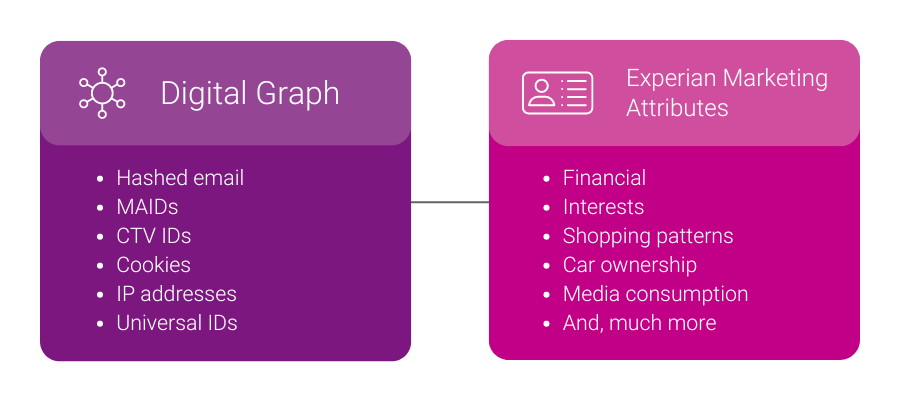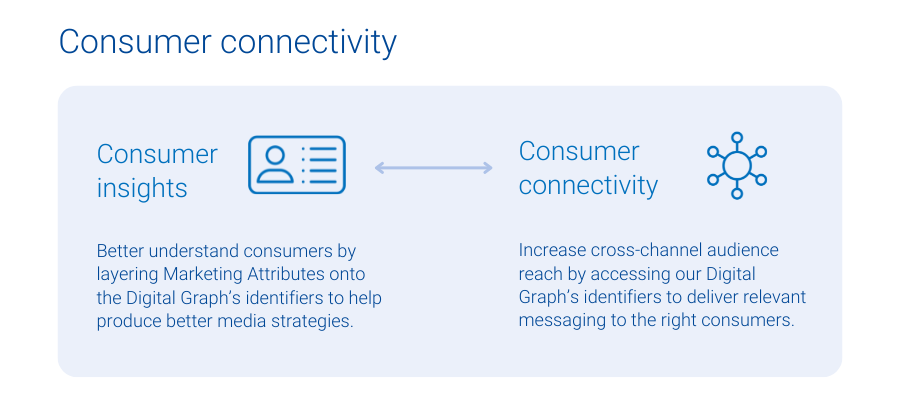
Experian, the leader in powering data-driven advertising through connectivity, is thrilled to unveil our latest solution, Digital Graph and Marketing Attributes. This joint solution supplies marketers and platforms with the insights and connectivity needed to understand who their customers are and reach them across digital channels.
The uncertainty around third-party cookies in Chrome and the overall decline in signal complicates the industry’s ability to reach the right consumer. Omnichannel media consumption results in scattered data, making it harder for marketers and platforms to understand consumer behavior and reach them across channels. These challenges call for a comprehensive solution.
Our Digital Graph and Marketing Attributes solution addresses these challenges by providing identifiers for seamless cross-channel engagement. By adding Marketing Attributes, like demographic and behavioral data, marketers and platforms also gain a better understanding of their customers. This solution uses Experian’s Living Unit ID (LUID) to combine offline and digital data, giving customers deeper insights into consumer behavior, greater audience reach, and improved cross-channel visibility.

Benefits of Digital Graph and Marketing Attributes
Both our Digital Graph and Marketing Attributes provide value to clients as standalone products. When clients license our Digital Graph and Marketing Attributes joint solution, they have more data at their fingertips, unlocking:
- Consumer connectivity: When clients license Experian’s Digital Graph, they get access to digital identifiers like mobile ad IDs (MAIDs), connected TV (CTV) IDs, hashed emails (HEMs), and universal IDs so they can target the right consumers with the relevant messages across all digital media channels.
- Consumer insights: Experian’s 5,000 Marketing Attributes provide our clients with detailed consumer information and insights, such as age, gender, purchase behaviors, and content consumption habits. Marketing Attributes help clients create more relevant messaging and informed audience segmentation.

Client examples
How OpenX offers richer targeting and more connectivity with Experian
OpenX is an independent omni-channel supply-side platform (SSP) and a global leader in audience, data, and identity-targeting. With industry-leading technology, exceptional client service, and extensive scalability across all formats, including CTV, app, mobile web, and desktop, OpenX has a legacy of innovating products that enhance buyer outcomes and publisher revenue while addressing complex challenges in programmatic.
In recent years, OpenX has licensed Experian’s Digital Graph with identifiers, contributing to the SSP’s largest independent supply-side identity graph, which offers advanced audiences to buyers and improved data resolution to content owners.
More recently, OpenX licensed Experian’s Marketing Attributes to enrich its supply-side identity graph, which includes IPs, MAIDs, and client IDs, with a variety of attributes. This strategic move has helped OpenX’s clients benefit from enhanced consumer insights and addressability, in turn delivering greater reach to the demand side and higher revenue for publishers, despite industry signal loss.
“We built on our long-term partnership with Experian to enrich our digital IDs with Experian’s Marketing Attributes, which help provide buyers better insights to audiences, thereby helping our publishers monetize their inventory. With partners like Experian, OpenX effectively facilitates the value exchange between demand and supply, ensuring our partners are able to drive results for their business in the era of signal loss”
Craig Golaszewski, Sr. Director of Strategic Partnerships, OpenX
How StackAdapt licenses our product bundle to address three different use cases
StackAdapt is the multi-channel programmatic advertising platform trusted by marketers to deliver exceptional campaigns. They drive superior results through a variety of solutions, like contextual and first-party targeting, brand lift measurement, and optimization through insights.
StackAdapt licensed a similar yet unique product combination, our Digital Graph and our Audiences. StackAdapt uses the Digital Graph to allow clients to onboard their first-party data in a seamless, self-serve manner that allows them to further segment their data using Experian Audiences.
“StackAdapt has been recognized as the most trusted programmatic platform by marketers, and with the integration of Experian’s Digital Graph and Audiences, we are strengthening our leadership in the space. This partnership improves our ability to deliver precise cross-channel segmentation, reach, and measurement, helping advertisers run more successful campaigns. Our collaboration with Experian allows us to offer a differentiated solution in the market and ensure our clients can deliver the most precise and impactful ads to their audiences.”
Denis Loboda, Senior Director of Data, StackAdapt
We recently announced a new partnership with StackAdapt. This collaboration brings the power of Experian’s identity graph, syndicated and custom audiences directly to the StackAdapt platform. Read the full details in our press release here.
Four ways to use Digital Graph and Marketing Attributes
When these two products come together, our clients have a 360-degree view of their consumers, which helps them power four critical use cases:
- Analytics and insights: Learn more about your consumers by connecting our Marketing Attributes with our Digital Graph’s identifiers. For example, a retailer can discover that their recent customers over-index as pickleball fans and players, leading the retailer to sponsor a professional pickleball event.
- Inventory monetization: When supply-side partners know their audience better, they can attract advertisers in search of that audience. For example, a publisher might find out that their audience is full of pickleball fans, leading them to reach out to brands that want to reach this audience.
- Activation: Companies with access to more digital identifiers from our Digital Graph can reach more people, while controlling frequency across channels. A company might know that they want to reach pickleball fans. Now, they have the digital identifiers needed to reach pickleball fans across all digital channels where they consume content, leading to increased reach.
- Measurement and attribution: Use the Digital Graph’s support for various digital identifiers to understand all consumer touchpoints, from media impressions to conversions. Then, lean on our Marketing Attributes to determine who your messaging resonated with. For example, a company uses our Digital Graph to know if it was the same individual who was exposed to an ad on CTV and converted via e-commerce. On top of that, the company can use our Marketing Attributes data to find out that the people who purchased were overwhelmingly pickleball fans.
Connect with us to learn more about how our Digital Graph and Marketing Attributes joint solution can provide the data and insights you need to create, activate, and measure cross-channel media campaigns.
Latest posts

As the nation slowly works its way up to full speed, it’s undeniable that the landscape has changed dramatically for every brand—especially when it comes to marketing and advertising. Many are looking for new ways to better connect with customers to meet their needs and encourage their continued patronage and loyalty, while others are attempting to reach out to a whole new audience who may not have known about them pre-pandemic. But even as brands are eager to get back to normal—whatever the new normal is—much like consumers, they’re faced with an uncertain future that may be affected by new financial restraints. For marketers looking to make a big impact on their bottom line, now is the time to consider pivoting advertising efforts to advanced TV (Connected TV/OTT and addressable TV). While traditionally cost prohibitive for many brands, the pandemic has greatly changed the availability of TV advertising. TV advertising is now more affordable than ever, opening up opportunities to brands who may not have had the ability to include it in their previous marketing plans. Whether it was due to the cancellation of live events or the delay of basketball season, or just general skittishness that’s keeping other brands from spending money on TV advertising, their pivot is to your benefit. There’s no question that consumers’ attitudes toward brands will have changed during the pandemic, which means they might need to be reminded of your brand and what it has to offer. There may be some who are seeing your brand for the first time, or for the first time in a long time. The good news is, people are watching TV now more than ever before. According to Experian’s Consumer Sentiment Index, television consumption is up 41% from mid-May to mid-June. Cable TV viewership has seen a 22% increase over the same period of time, showing that consumers are still connected to traditional TV viewership. Another reason why now is a great time to make advanced TV part of your marketing plan. While many states are still rolling out their re-opening plans, many consumers are still working from home, and the job landscape is still firming up. That means your customers will still be passing the time at home as the landscape continues to shift and change, and their attention will likely be directed toward their TVs. Plus, with consumer spending starting to rebound, you can benefit from this directed attention in a new medium. And consumers aren’t just watching TV on their televisions. Smartphone use is up 41% over last month, as is desktop/laptop use at 38%, and tablet use at 21%. And, when they’re not watching their favorite show on their phones, computers or tablets, they’re visiting advertiser websites and using apps more heavily. This means that brands can supplement their TV advertising with an omnichannel approach to ensure their consumer can connect with them through any device they’re using. All of this may sound intimidating to brands who haven’t previously advertised on TV or executed an omnichannel campaign, but rest assured that the power of data can help make the experience fairly seamless. A data-driven marketing strategy can help brands better understand their audience, including demographics, lifestyle, behavior and attitudes—as well as their preferred engagement channels. This helps ensure that your message resonates and is seen on the devices and channels your audience frequents most. With Experian’s 50+ years of experience with consumer data, you can rely on us to help you execute a data-driven advanced TV campaign that targets the right audience with your message. And we collaborate with all TV operators and have connections with many industry media partners, so you can choose exactly where you want your outreach to go. Find out more about how Experian’s Advanced TV capabilities can help you have more meaningful interactions with people: https://www.experian.com/marketing-services/television-advertising.

Retailers have always known that building a loyal customer base is the key to success. But whether they’d successfully done so or were still working towards their customer loyalty goals in Q1 of 2020, the global pandemic changed everything. With shoppers shifting purchasing habits almost solely online, retailers with an established online presence were able to navigate stay-at-home orders and other business restrictions. As of June 9, 2020, according to Experian’s Consumer Sentiment Index, half of Americans (47%) are buying more online than they did in the past. So those who previously relied on their brick and mortar business may have had difficulty staying afloat. Undeniably, the landscape has shifted dramatically, and it’s about to do so again as stay-at-home orders are lifted and retailers are being given the green light to re-open, albeit with guidelines and restrictions they’ve never faced before. With so many different messages that need to be shared, and the need to stand out among thousands of other retailers working to grab the attention of the same audience, mobile location data is an important tool in a retail marketer’s arsenal. For example, so much of the in-store experience moved online at the start of the pandemic. As a result, a lot of consumers have gotten comfortable with that format and may be apprehensive about the in-store experience, especially with all the changes required for re-opening. Using mobile location data, retailers can identify audiences that are more likely to return to in-store visits, and tailor messaging to address their questions and concerns to encourage their patronage. They can effectively communicate information surrounding the rules for in-store shopping, including face masks, social distancing, how they plan to protect their clientele, and more. If, after sharing their re-opening information, retailers find customers aren’t coming to them but are instead visiting competitors, mobile location data can help them determine consumer patterns based on competitor shopping to gain a greater understanding of why they’re shopping elsewhere. Using this information, retailers can adjust their outreach to better speak to their target customer and their needs, and encourage their visit with more relevant messaging. And of course, there will still be some customers who feel more comfortable continuing with online shopping. Mobile location data can also assist brands in identifying those audiences so that they can adjust their communications strategies and messages accordingly. Meanwhile, many retailers have shifted from a buy online pick up in store (BOPIS) model to buy online pick up at curbside (BOPAC), both for convenience and safety. As restrictions lift, some will soon be shifting back to BOPIS. Mobile location data can help you determine if this is a more preferred method of shopping by analyzing consumer behavior. If customers aren’t ready for an in-store visit but still have needs that could be met by a particular retailer, that brand can create messaging that supports their desire to do their shopping online and pick up their purchase—whether they come inside or opt for curbside pickup. The more retailers know about their customer’s habits, behaviors and interests, the more they can address their needs and concerns with personalized messaging that can make an impact. Additionally, because so much of life moved online during the pandemic, consumer data may be even more fragmented than before, with their attention spread across multiple devices and channels. Using mobile location data—in combination with demographic and psychographic data—retailers can learn more about consumer behavior, including stores visited, shopping preference insights, hobbies, and more. While the retail industry is facing incredible challenges in the wake of unprecedented change, the right data can help them bridge the gap between where they were, and where they want to be—especially when it comes to nurturing consumer connections. And as retail marketers work on new messaging that shares their unique plans for re-opening and emerging post-pandemic, how that communication is delivered, and who it’s delivered to, could make all the difference in a successful re-opening plan. Contact us today to find out how more about Experian’s retail marketing solutions. And be sure to check out our other retail blog posts as well.

Article written by Jill Canetta, Experian Marketing Services’ Chief Data Officer, and Mark Pryzbylski, Experian Automotive’s Senior Director of Product Management At this point, it’s indisputable that the COVID-19 pandemic has completely changed everything for everyone on a multitude of levels. And now that the country is moving toward easing stay-at-home restrictions and people are starting to venture out into the world, auto marketers are faced with unique challenges amid an uncertain future and customers who aren’t sure of the best step to take next in their ownership experience or potential vehicle purchase journey. However, that uncertainty provides an opportunity for brands to make deeper connections with current customers and interested consumers—provided they can understand and address their customer’s needs in a supportive way. You need to lead with empathetic messaging that directly addresses their needs and offers support during this challenging time. Data is the starting point, and Experian is ready to help. First, you need to understand what consumer outlook looks like on a national scale, in real time. Using insights gleaned from consumers across the country, Experian created a US Consumer Sentiment Index built on daily survey findings that outlines what customers are thinking and how they’re feeling during COVID-19. As of June 10th, 2020: 44% have automobile payments they need to make monthly, with Millennials and Gen X leading the pack at 50% 21% are considering buying a new vehicle within the next few months, with Millennials at the forefront of this drive at 16% Of those considering a new vehicle, 63% will continue with their purchase as planned, 42% will buy something less expensive, and 18% will consider leasing, with Gen Z leading the last two these categories Certainly, this data can help auto marketers glean the information they may need to begin targeted outreach, especially when sentiment shows there’s still a need and desire to own, lease or rent a vehicle. But this is only part of the picture. To create a complete view of the customer, marketers need to fill in the blanks so they can thoroughly address their needs and let them know they’re both ready to help, and capable of doing so. For example, due to the changing landscape, it’s unlikely that dealership walk-in traffic is going to present the same opportunities for purchase that it once did. This means marketers will have to leverage new avenues to execute their outreach. Using the power of data, auto marketers can identify those who are most likely to be in the market for a new vehicle, such as those coming to end of lease or those who are soon to be in equity on their current vehicles. But how can this information help you in your outreach efforts? Demographic, behavioral, life event, lifestyle, automotive and attitudinal data can help you tailor a compelling message to address their stage of ownership—and potentially address their new or emerging needs as a consumer. Perhaps their child is starting college in the fall and needs a vehicle. Or maybe they’ve downsized and don’t need an SUV anymore, so a compact car would better fit their needs. When it comes to leaseholders, data can show you which leases are coming up for renewal or termination. Regardless of their situation, leaseholders will need to decide on their future vehicle needs whether it means buying their car, leasing another, or going in an entirely new direction—one that may potentially be more cost effective to address the issues they may suddenly be facing. Beyond identifying your target audience, you need to understand how to reach them. We also offer the opportunity for multi-channel media activation, leveraging our relationships with more than 100 media partners and digital platforms to launch and optimize your one-to-one marketing campaign across all channels. And to help you determine the ROI of your offline and online campaigns, our measurement tools help you gain actionable insights for future campaigns with easily digestible dashboards and reports. As we all adjust to the new landscape and find different ways to navigate the current environment, marketers need to be cognizant of how they’re targeting new consumers—especially when the landscape appears to be unstable. By addressing consumers with relevant and thoughtful messaging that supports their needs, marketers now have the opportunity to create deeper connections that can create loyalty that lasts a lifetime. Learn more about how the Experian Marketing Engine for automotive marketers can help.